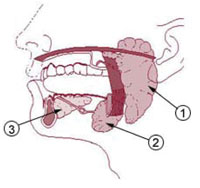Salivary glands
Glands are organs of the body which produce natural substances such as hormones and breast milk, and fluids that keep the body in fluid balance. Salivary glands are organs that produce saliva and release it into the mouth, particularly when we are hungry and when we are chewing food. There are three pairs of salivary glands; their names and locations are shown in Figure 6.4. Their names tell you where they are located: parotid means 'beside the ear', sublingual means 'under the tongue', and submandibular means 'under the jaw'.

If the salivary glands don't function properly due to disease or an injury, the amount of saliva produced decreases and the mouth becomes dry. This is unpleasant for the affected person, it makes chewing and swallowing food more difficult, and it increases the risk of tooth decay and gum disease. There may also be a bad smell from a dry mouth, because saliva naturally keeps the mouth clean by washing away bacteria and small particles of food.